It’s been a while since I visited Palau earlier this year. In fact, it’s been five months.
I’ve been eager to share some photos and write about my first substantial visit to the island nation since 1995, but I had to wait for two things. First, the trip was courtesy of Sam’s Dive Tours, Planet Blue Kayak Tours, and Sport Diver Magazine. As such, I had to wait for the article to come out in the June issue of the magazine: Hidden Palau, Sport Diver June 2011, 1.3MB.
Second, I had to wait until I returned from my recent trip to Papua New Guinea, where I was for the entire month of June. Since getting back, I’ve been swamped catching up with work, dealing with life’s little chores, and getting ready for my annual migration to the southern hemisphere to frolic with humpback whales.
So...realising that the only way I was ever going to write this post was to isolate myself...I’ve just escaped to a little bar in the basement of a building in Tokyo where I’m scheduled to meet some friends later tonight. But since it’s the middle of the day, there’s no one here, and there’s no 3G or Wifi signal. I have a pot of coffee beside me and a fully charged laptop battery, so here goes...
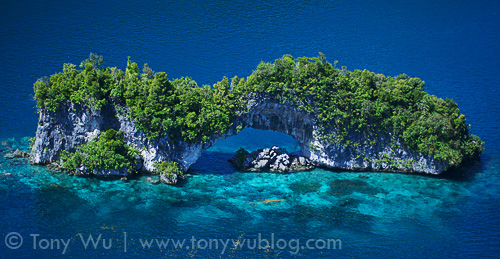
Aerial view of the Natural Arch formation in the Rock Islands of Palau
Dive Different
If you’ve been reading my blog for any reasonable period of time, you’ll know that I have a penchant for going to relatively unexplored places and doing unusual things. I like to “Think Different”, to borrow Apple’s slogan.
Palau is a wonderful place, with fantastic diving, but the islands don’t really fit my preference profile. It’s not particularly difficult to get to Palau, and there are literally dozens of boats ferrying hundreds of divers every day to well-known reefs. That, in short, is the reason I had not travelled to Palau to dive since 1995.
So...when I received an email asking whether I’d be interested in an assignment in Palau, I initially wasn’t all that excited. But one part caught my eye, a description of the trip as a: “very cool opportunity to shoot some places in Palau that don't normally get covered in dive publications”.
Curiosity piqued, I pinged a few emails back and forth with friends in Palau and with the magazine, and soon realised that this could be a unique opportunity...a chance to explore some of the hidden, relatively unknown areas of otherwise well-known Palau, if that makes sense.
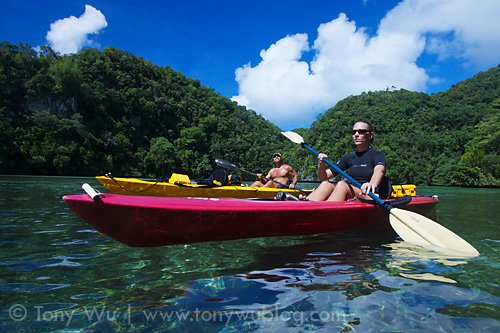
Exploring Palau by kayak offered a unique perspective
for a well-explored destination (and a great tanning opportunity!)
Specifically, the core concept of the trip was to explore Palau’s Rock Islands by kayak, meaning that we’d be going nice-and-slow through some of the most picturesque, untouched regions of the island nation.
By day, we’d explore inner waterways, clamber up sharp limestone formations, snorkel and scuba into hidden lakes, paddle under lush overhanging vegetation, and crawl through tight, submerged tunnels to see isolated, virgin coral formations. By night, we’d camp on beaches, dine al fresco, and sleep in tents.
I mean...how cool is that?!!!
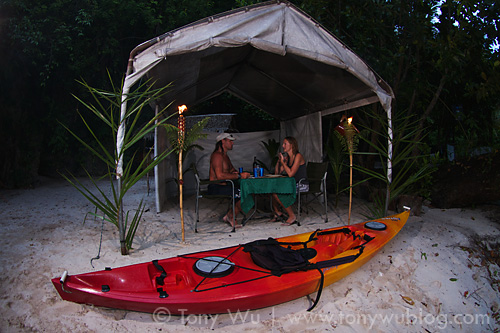
Dining al fresco in the evening at Blue Devil Beach after a day of paddling
Who’s Who?
The cast of characters for this trip was short.
Ron Leidich was our guide. He’s lived in Palau for a long time...I think something on the order of 15 years...during which time he’s done the dive-guiding thing, but more recently, he’s been devoting time to exploring every nook and cranny of Palau’s Rock Islands...discovering, in the process, some pretty amazing stuff.
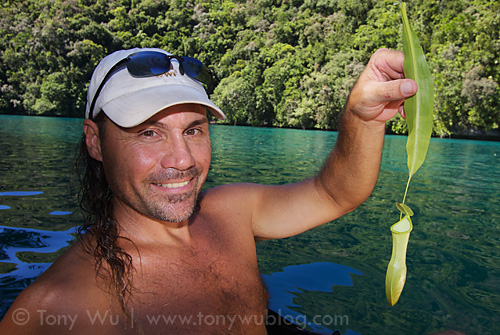
Ron showing us an insectivorous pitcher plant (Nepenthes mirabilis)
while we were paddling to Disney Lake in Neco Bay
Ron and I are about the same age (physically, and tragically...also mentally). Within hours of first contact, we got along like long-time drinking buddies...cracking stupid jokes, making obscure references to old movies, imitating cartoon characters, singing bad ‘70s and ‘80s tunes (Ron, not me!), and generally just acting like the (im)mature adults(?) that we are.
Anyway...poor Terry. The magazine sent Terry Ward to write the article, which meant: (a) I didn’t have the pressure of taking notes, and (b) she had to put up with our nonsense. From my point of view, (a) was terrific. From her point of view, (b)...probably not so much.
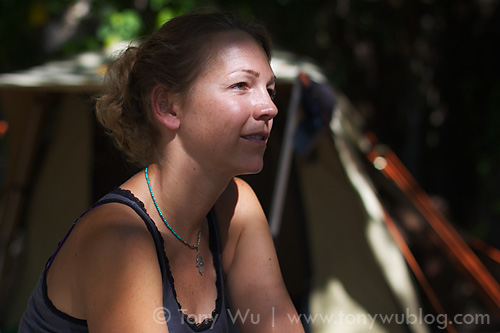
Terry listening to Ron's briefing for the adventures ahead
In the beginning, I could tell that she wasn’t quite sure how to handle us, but good sport that she is, Terry became inured to us for the most part within a couple of days, and either ignored the insanity, or just shook her head from time-to-time in a vaguely parental manner.
Then there was Malcolm Maltel, who was arguably the most important person on the trip. He was our cook. Malcolm made outstanding(!) food, and lots of it...certainly a great way to wrap-up each long, tiring day.
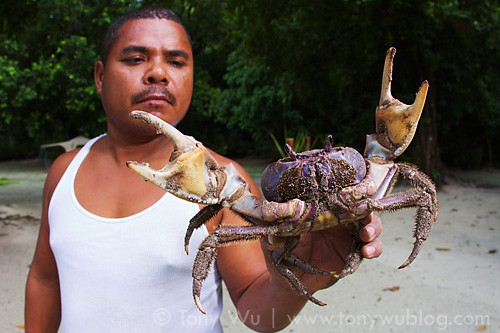
Malcolm holding up a Palau land crab (Discoplax hirtipes)
Malcolm also has an encyclopedic knowledge of the islands’ flora...comprising not just names of plants and flowers, but also traditional uses (food, medicine, etc.), some of which he shared with us during the trip.
Ron’s knowledge of the islands’ plant life is also incredible. Try as I might, there were few times when I could stump the two of them with a plant ID. Ron and Malcolm are working together on a guide book of Palau’s flowering plants, a draft of which we saw. It’s an incredibly detailed collection of information and pictures, including many things that probably haven’t been documented to date.
Rounding out the motley crew was Jefferson Nestor, who was in command of our support boat and made sure our considerable load of junk made it from point to point every day. Jefferson has one of the most infectious smiles I’ve ever come across (and of course, doof that I am, I didn't take a good photo of him). I tried to make him laugh as often as possible, just to enjoy his amazing grin.
Twists, Turns and Tunnels
Perhaps the most significant thing I learned on this adventure was that even the most well-known places have secrets.
As I alluded to earlier, Palau is one of the most popular and frequently visited dive destinations in the world...for good reason. The reefs are teeming with life, and signature sites like Blue Corner, German Channel, and others rarely fail to deliver. If you’re a diving addict, it’s a must-do destination.
The thing is...there’s actually a lot more to Palau. Places that most tourists never see. Heck, places that even people who live in Palau don’t visit.
It’s to some of these places that Ron took us.
To access some of Palau's hidden secrets, we had to navigate through tunnels, sometimes fully submerged, sometimes partially so. In certain cases, the fit was so tight that I felt like a contortionist folding myself into a tube of toothpaste.
As if that weren’t challenge enough, I had to drag camera gear through as well...Ouch!
Anyway, this photo pretty much sums up what the experience was like:
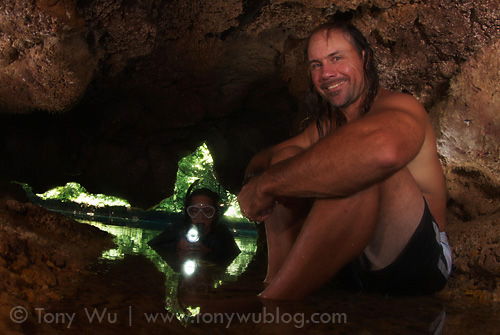
Ron and Terry in one of the tunnels we traversed,
hidden lake visible in the background
We had to pick and choose the times we went through (and more importantly, headed back), as being on the wrong side of the tunnel at the wrong time could have turned into a less-than-enjoyable experience. In this case, as we crawled through, I carried my camera along bit-by-bit, setting it on the rocks as I made progress. (All those tedious hours in the gym finally paid off.)
There were hydroids covering the bottom of several tunnels, which gave Terry butt burn on at least one occasion. As you can perhaps surmise, both Ron and I thought that was rather amusing, though we (mostly) laughed behind Terry’s back...out of respect. Ron seemed immune to stings, perhaps from repeated exposure or just to a thick hide. I was always fully covered, so managed to avoid getting stung.
Anyway, you might be wondering, “Why bother going to this trouble?”
Well, on the other side of tunnels and passages like the one pictured above were pristine environments. Emerging from a tunnel into one of these unspoiled lakes was like finding myself immersed in a scene from the movie Jurassic Park...minus voracious prehistoric predators with menacing teeth, of course.
Above water, plants draped themselves across the rocks and one another, creating beautiful hanging gardens over the enclosed saltwater lakes, with birds nesting among the tropical foliage in complete safety. Normally shy tropic birds, for instance, flew low to the water, passing right over our heads. On one occasion, we saw a pair mate in mid-air, setting new standards for the Mile High Club!
Beneath the water's surface, there were communities of undisturbed corals, and sometimes even populations of fish and other marine life that have been largely isolated from their cousins in the open ocean.
With nothing to disturb them, many corals in these secluded environments have grown to large proportions; some that we encountered were so fragile and thin that they were translucent.
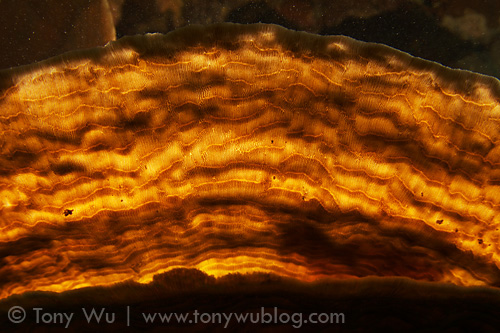
There were corals in the lakes so fragile that they were translucent.
This is the lava-like edge of a large Pachyseris speciosa formation.
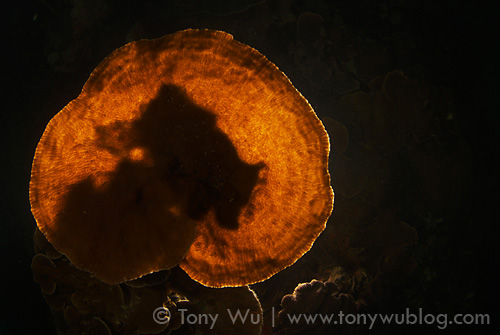
Another example of translucent coral (Merulina sp.) in Palau's Rock Island lakes
Of course, the visibility in these enclosed environments and nearby waters wasn’t terribly good.
But that was, in a sense, the whole point.
You see, protected places like these hidden lakes, other semi-enclosed shallow-water areas, sheltered mangrove forests and the like...serve as nurseries for many fish and other species of marine life...places of sanctuary.
In other words, a significant part of the reason that that the reefs of Palau are so healthy and such a magnet for divers from all around the world is because there are so many protected, pristine areas like this scattered among the Rock Islands, where corals flourish, young fish grow in safety, and marine life gathers to reproduce and disseminate.
No safe, hidden, murky environments = no healthy coral reefs and tropical fish.
It’s all connected.
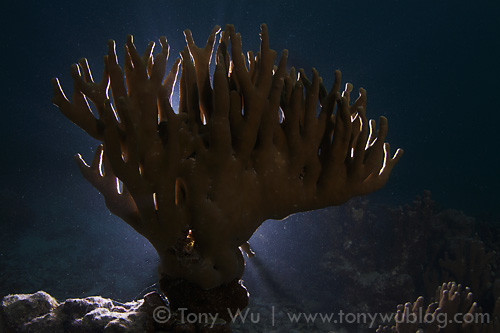
Shallow, protected places have murky water, but provide a safe environment
for corals to flourish and develop into intricate, unbroken formations
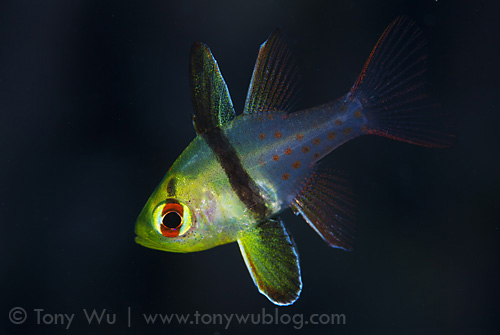
Calm, shallow environments provide shelter for many juvenile animals,
like this baby pajama cardinalfish (Sphaeramia nematoptera)
Teasing Terry
Remember I mentioned “Poor Terry” above? Well, to give you but one example of what she had to put up with...
Among our many unique experiences, Ron took us to a place where he’s often come across piles of banded sea kraits (Laticauda colubrina) hauled up on the rocks above the water line. They seem to enjoy resting in groups of several individuals, as they were doing when we visited.
I know these amphibious reptiles climb onto land to lay eggs, so I was hoping to see some eggs, or at least some sign of egg-laying. But nope. Ron’s never seen any eggs either, so it’s a bit of a mystery why the animals gather on these rocks. Perhaps it’s just to take a break from swimming?
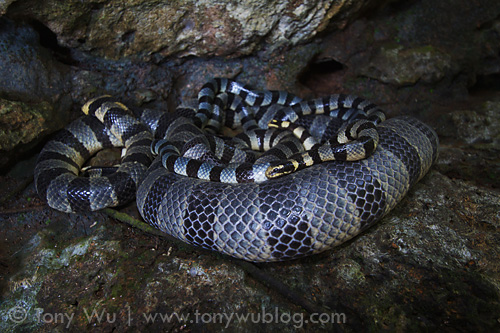
A pile of four or five venomous banded sea kraits (Laticauda colubrina)
lounging on a shaded rocky ledge in the Rock Islands of Palau
Anyway, to see these animals up close, Terry and I had to dismount in a ginger fashion from the bow of the boat while it was sloshing up and down with the surge, and then scamper up the rocks, with the sea directly below us (while carrying camera and lenses, in my case).
So basically, we were perched on a steep limestone cliff face, surrounded by piles of slithering sea kraits, with no escape route if one of the reptiles took a fancy to us, or if more slinked up the rocks to join their friends.
Like other marine reptiles, these intriguing animals boast a powerful venom. I’ve never heard of anyone being bitten, and despite their sinister appearance, sea kraits are probably too intelligent to even consider wasting their precious toxin on us.
Sometimes, logic doesn’t really matter though.
In case it’s not entirely obvious from the photo below, Terry was scared. Actually, just saying she was “scared” is somewhat insufficient. “Scared ----less” would be closer to the truth.
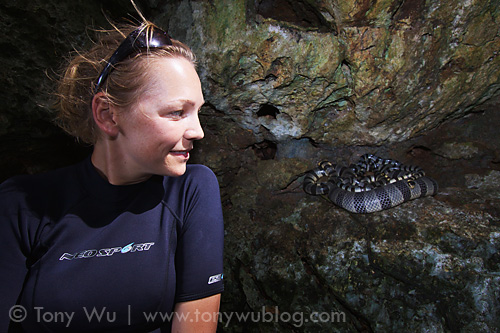
Terry bravely facing down a den of slithering sea serpents
Obviously...it was too good of an opportunity to pass up. While she was moving among the rocks, looking for a safe, non-krait-occupied spot to settle down, I pointed behind her and belted out: “Look! There’re more coming up behind you!”.
In rapid succession came squeals of panic from Terry, then howls of laughter from Ron, Jefferson and Malcolm...all of which were audible above the sound of waves smashing against the island. Impressive, no?
Of course...there weren’t any sea kraits climbing up behind her. I should’ve felt bad, but I was too busy chuckling and trying not to drop my camera.
Poor Terry.
Life Will Find A Way
In addition to the hidden lakes, there are other transitional zones nestled among the passages and crevices of the Rock Islands...areas that create unique ecosystems and often provide safe havens for marine life.
One of Ron’s favourite places is a formation of multicoloured Lobophyllia coral he’s named “The Four Corners”.

The Four Corners Lobophyllia coral formation
that Ron loves so much
I’m no coral expert, but as I understand, Lobophyllia (often referred to as brain corals, for obvious reasons) are hardy animals. They’re generally found in shallow waters, where there is a decent amount of light to support the symbiotic zooxanthellae that impart colour to them, and more importantly, synthesise food for them.
Ron has found an area where the conditions shouldn't be so good for these corals, but where they flourish nonetheless...a place he calls Darwin’s Wall as a nod to the cerebral common appellation for Lobophyllia.
There's not a lot of sunlight that penetrates the canopy of overhanging trees at Darwin's Wall, and the water is also murky...meaning that the zooxanthallae embedded within the coral polyps probably can't produce a lot of food, certainly not enough to support the size and abundance of corals present in the area.
Instead, the large colonies of brain corals that live and thrive here may be relying more on nutrients brought to them by large volumes of water flushed daily through two tunnels that connect a large inner lake and the open water.
I know...not all that exciting to a normal person...but if you think about it, the Lobophyllia corals at Darwin's Wall illustrate the critical point that Jeff Goldblum's character in Jurassic Park made: "Life will find a way."
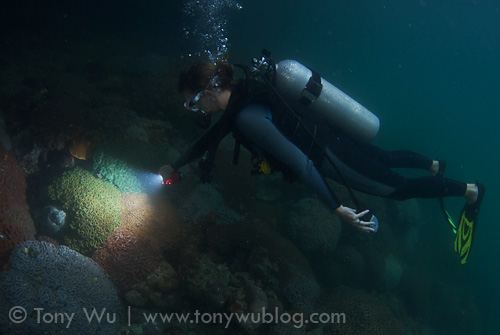
Terry shining a light on multicoloured
Lobophyllia brain coral at Darwin's Wall in the Rock Islands of Palau
Another example Ron showed us of life finding a way was in the Patch Reefs, a system of shallow-water coral reefs situated (in both a conceptual and physical manner) between the really mucky waters of the inner lagoons and the crystal-clear blue of the true open ocean.
Back in 1998, there was a really bad El Niño event that affected the entire the Pacific. I remember reading stories of mass devastation to coral reefs, accompanied by a chorus of proclamations that it would take hundreds, maybe thousands, of years for reefs to recover...if ever at all.
Doom and gloom all around.
Well...here's one of those reefs that was devastated first by El Niño, and then by a massive crown of thorns starfish attack that left the entire area a crumbled, bleached-out wasteland:
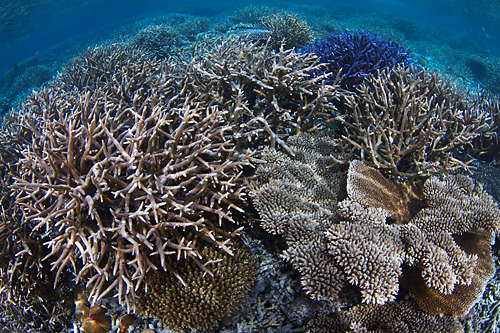
Thriving coral reef in an area that was devastated by
El Niño in 1998 and crown of thorns thereafter
Sure doesn't look like the perma-wasteland that so many divers, conservationists, scientists and other miscellaneous authorities asserted that it would be, does it?
Of course, most people would agree that in a perfect world, it's best for reefs not to experience destruction due to El Niño events, plagues of crown of thorns starfish, or the carelessness of man.
But what this shallow-water reef and others around Palau (as well as the entire Pacific region) clearly demonstrate is that nature isn't as frail and helpless as humanity too often assumes it to be.
Under the right circumstances, as here in Palau, where an intricate web of independent, but interdependent, ecosystems support one another..."Life will (definitely) find a way."
In fact, it'll do more than that. It'll thrive, as evidenced by the diverse array of colourful juveniles and shallow-water current feeders I found amid the nooks and crannies of the Patch Reefs.
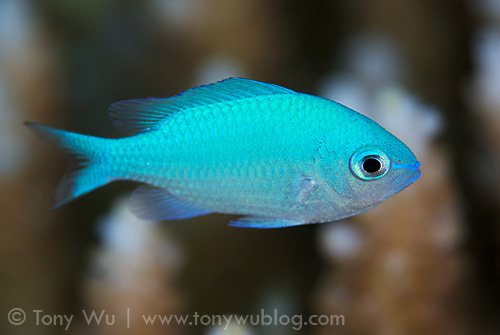
Brilliant juvenile chromis at Fantasy Island in the Patch Reefs
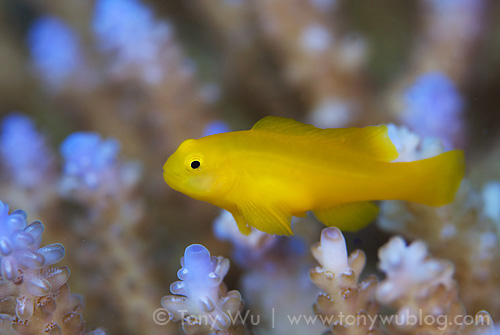
Among the thriving Acropora coral at Fantasy Island
were many cute yellow coral gobies (Gobiodon okinawa)
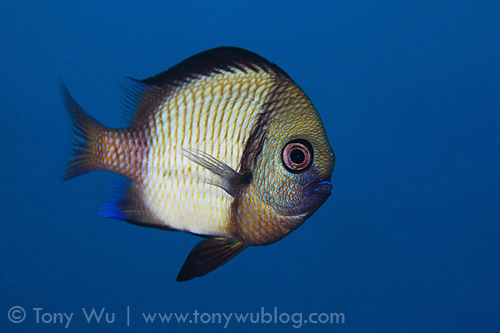
Dascyllus carneus, a fast-swimming fish that typically lives among
healthy corals on shallow reefs, snatching food from current
Learning to Kayak
One thing I forgot to mention to everyone before heading over to Palau was that I had never kayaked before. Oops.
I didn’t say anything until the first morning, when, with kayaks fully loaded, Ron exclaimed, “OK! We’re ready. Let’s go.”
I raised my hand and said: “Um...how do you get in?” to stunned expressions from all concerned. At that point, I had no choice but to fess up and admit that I’d never kayaked before.
Terry laughed. Ron looked baffled, but took it in stride. He gave me the 45-second Idiot's Guide to Kayaking explanation of what to do, and off we went.
I’m proud to say that I had no problems. It took a few minutes to get the hang of using the double-sided paddle, but I managed to steer in a (relatively) straight line, and even handled swells and waves with no issue. I didn't hit any islands either.
When we stopped to check things out, dismounting and re-mounting posed a minor challenge the first couple of times, but I did well. I have no doubt that Ron was proud of me.
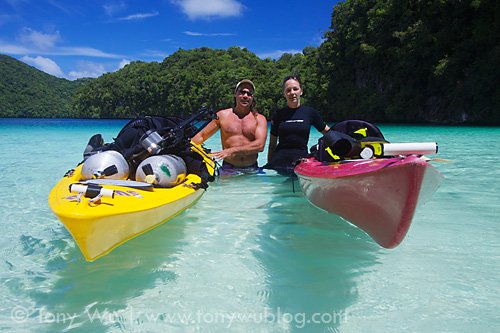
Ron and Terry striking a pose with gear-laden kayaks
Until I flipped.
Before I elaborate, I just want to be clear that I did not flip due to difficult conditions. I flipped in glass-calm water, with no current, no wind, no waves, no menacing wildlife...nada.
Even better...I flipped twice.
So here’s what happened.
The first time, Ron was showing Terry and me how to glide under a low-hanging arch. Basically, paddle to get a bit of momentum, then lean back until you’re flush with the kayak and float through the arch to the other side. Sort of like doing the limbo, but seated in your kayak.
Ron demonstrated. Looked easy. Terry went through. No problem at all. I headed to the arch, leaned back. Everything was going just peachy until I remembered the sole admonition from Ron. During his explanation, Ron said that the one thing we shouldn’t do is lean right or left.
Now...when someone tells me not to do something, I have a tendency to, well...do it.
So “FLOP!” over I went. Ron sure knows his stuff. All I did was lean a really tiny, little wee bit to the right and before I knew it, I was upside-down. Didn’t even have time to blink.
Fortunately, the water wasn’t deep. It was barely chest-high, so I surfaced immediately, laughing so hard I could barely breathe. Of course, all the carefully packed equipment in my kayak was now on the sea bottom, so it took a while to regain my composure and un-discombobulate myself.
All Ron and Terry could do was shake their heads as they waited in the distance for me.
Now, once should’ve been enough to teach me a lesson, but never let it be said that I learn quickly.
The second time I flipped was...you guessed it...once again in dead-calm conditions.
We were paddling through a narrow mangrove area called Long Lake. It’s one of the most beautiful places I’ve ever had the good fortune of visiting.
The narrow tunnel formed by mangroves and other plants, the birds, the serenity...infused me with the same feeling of awe I get when I visit Hachimangu Kinomiya Shrine in Izu...that of being at one with nature, at peace, centered.
Anyway, as I looked up at the trees, paddle in hand, just floating along basking in the purity of Mother Nature...once again, Ron’s warning came to mind, and yup...over I went once more, this time to the left.
And once again, the water was shallow, so it was basically a repeat performance, with me scrounging around in the soft muddy bottom looking for everything I’d just spilled out of my kayak. Sheesh.
As it turned out, I took my spill in a perfect place to take a couple of photos to illustrate the integral role that mangrove forests play in the health of a complex ecosystem, and also to show how intricate mangrove tree root systems are:
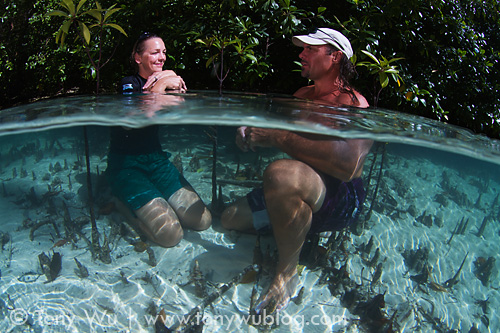
Ron explaining the importance of mangroves to Terry
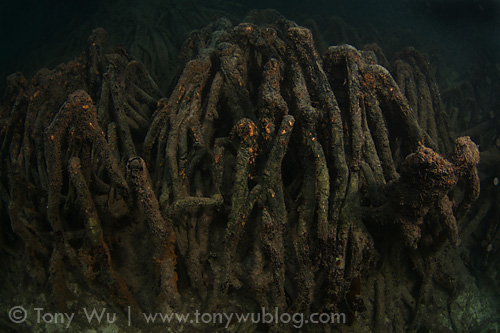
Intricate arrays of mangrove roots provide shelter for many juvenile animals
I tried explaining to Ron and Terry that I’d chosen that specific spot to take a spill because I knew that it’d be a perfect place to take photos...but they wouldn’t have any of it.
So, even though I flipped over twice, I got some nice pictures as a result, and also got to spend time in the most beautiful mangrove area I’ve ever visited.
Open Ocean
Of course, a trip to Palau wouldn’t have been complete without a visit to some of the nation’s world-renowned blue-water dive sites. So, toward the end of our trip, we managed to do one dive each at Blue Corner, the Blue Holes, German Channel and Ngemelis.
The days we had spent exploring the hidden lakes, inner lagoons, mangrove areas and shallow-water reefs of the Rock Islands helped me to appreciate those dives in an entirely new light. Kayaking with Ron’s guidance through the hidden environments of the Rock Islands had “pulled back the veil” so to speak, and given me an opportunity to see what underpinned the health of Palau's world-famous reefs.
I won’t bore you with too much narrative about the blue-water dives...just a brief mention of the highlight for me of our handful of “normal” dives, which was having the opportunity to spend some quality time with a juvenile spotted eagle ray (Aetobatus narinari). I’ve always been a fan of these graceful animals, possibly because of their permanent mickey-mouse grin.
I learned that the Palauan word for eagle ray is the same as that for Audobon shearwater, and both are considered gods. So basically, I photographed a smiling baby god. Doesn’t get much better than that.
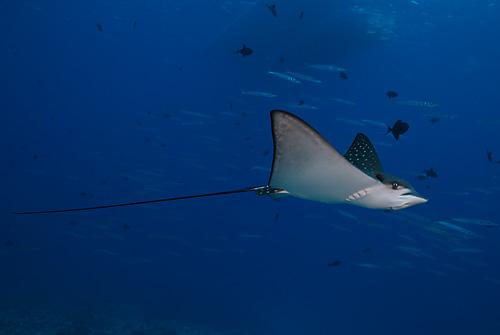
A baby eagle ray (Aetobatus narinari) at Blue Corner,
with dive boats and barracudas visible behind
Cavorting With Crustaceans
One evening, just before dinner, we somehow got on the topic of land crabs. I seem to recall that the discussion had something to do with catching land crabs to eat for dinner. They’re absolutely delicious, especially when a master like Malcolm prepares them.
Anyway, he casually let slip during the chat that female crabs would be heading to the water to release eggs soon.
Whoa! Hold the press. That immediately caught my attention, so much so that I actually forgot about dinner, and asked for more information.
In a staid, matter-of-fact tone, Malcolm told me that female land crabs in the Rock Islands make their way to the sea starting a couple/ few days before the full moon, when the high tide coincides with nightfall, to release their clutch of fertilised eggs into the water.
As it turned out, it was two nights prior to full moon when he told me that. It was also just before nightfall. The tide was almost high. And my camera equipment was anything but ready...Aiyah!
So...just as the female crabs were preparing to head to the waterline, I mumbled something to the effect of “Malcolm, you really have to give me more notice than this.” and scrambled (probably in a crab-like manner to any impartial observer) around our campsite, slapping a camera into a housing, attaching strobes to arms, digging out an underwater light, fumbling with various clamps to put everything together...generally creating a ruckus and working up quite a sweat.
Just as I got everything together, we spotted a single female heading to the water. I rushed over (probably, with multiple strobe arms dangling from my camera housing, appearing crab-like to any impartial observer) and followed her in. She was hesitant at first, but when nature calls, nature calls...so within a few minutes, she did a mad happy-hoppy dance to cast her eggs into the water, getting knocked sideways every once in a while by the surf.
It wasn’t easy holding up my camera rig (I really wish camera equipment could be less heavy) and following the frantic movements of the crab and surf, but I did manage to get a few photos:
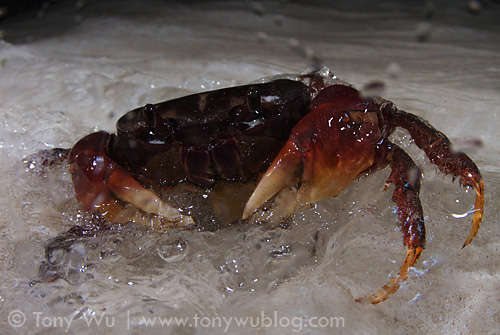
A female land crab (Cardisoma sp.) releasing eggs into the surf zone
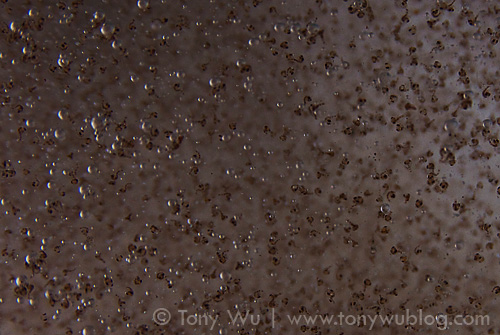
Crab larvae visible at high magnification. See the pairs of eyes?
I looked for egg-laden females again the next couple of nights, but as is often the case, when I was actually prepared, nothing happened. C’est la vie.
Wrapping Up
As you’ve no doubt gathered by now, it was an eventful trip. The anecdotes above are just a few highlights of what Terry and I experienced and learned in Palau, thanks to Ron, Malcolm and Jefferson.
Logistically, this was one of the most challenging excursions I’ve done. Since we were on kayaks, we had to carry everything that we needed during the day...masks, snorkels, fins, wetsuits, scuba tanks, BCDs, underwater cameras, land cameras, changes of lenses, etc.
Moreover, everything had to be waterproofed (particularly given my talent for flipping over in calm water), and I had to have rapid access to all my gear, because often, the light and/ or current was just right only for a matter of minutes.
There was a lot of area to cover in much too short of a time, with many of the places Ron wanted to take us requiring pinpoint timing, down to the hour or so. The weather was unseasonably rainy and windy, which put on damper on many of our plans.
At night, the humidity was high, we were covered in salt, sand and sweat...and we had thunderstorms to boot (Lightning struck ground near us a few times, which was a stimulating sensation!).
Which of course meant I didn’t want to break open my cameras or deploy my computer and hard disks. Oh yes...I had my laptop, hard disks, batteries, chargers and lots of other sensitive electronics with me. We had a portable generator (that Sam's Tours procured just for this trip), which I tried only to fire up every other day, in the early morning, when there was sufficient light for me to see and fully appreciate the myriad ways I could destroy my gear.
Suffice it to say that I was in a constant state of equipment-related anxiety...but it was definitely worth the effort.
Besides gaining first-hand insight into some of the hidden intricacies of the Palauan ecosystem, I made some great friends and had lots of fun, which is, after all, what travel and life should be about.
In all openness, this isn't the type of trip that everyone will enjoy or should try.
If you've never been to Palau, then I'd definitely recommend doing a more standard dive itinerary for your first visit.
But if you're adventurous, somewhat of a biology geek, enjoy getting out in to the fresh air, and don't mind being away from the creature comforts of a hotel room, TV, aircon, etc., then this is an adventure of a lifetime. You'll see, experience and learn so much that it's hard to take it all in.
If you’d like to learn more about diving in Palau or exploring the Rock Islands by kayak, definitely get in touch with Sam’s Dive Tours.
On that note, it's time for me to order a beer, as my friends will be showing up soon. I’ll conclude with a few more photographs from the trip, in no particular order:
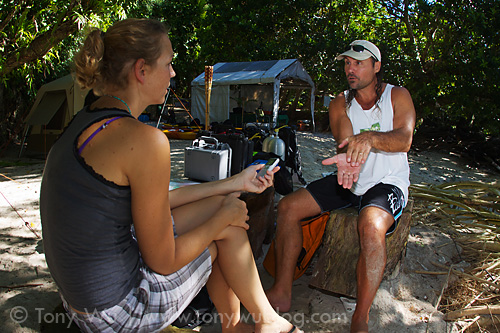
Terry getting background information from Ron
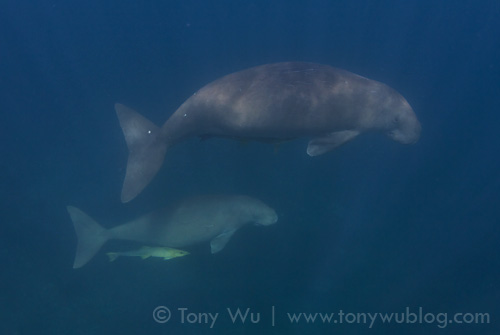
Chance encounter with a pair of dugongs in Palau
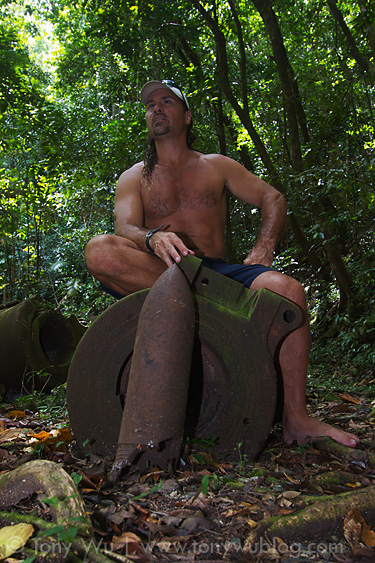
Ron sitting on the remains of Japanese artillery from WWII
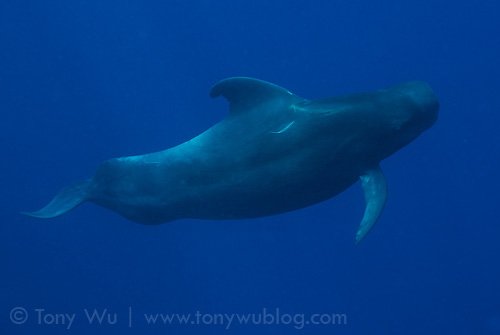
We came across a pod of short-finned pilot whales (Globicephala macrorhynchus)
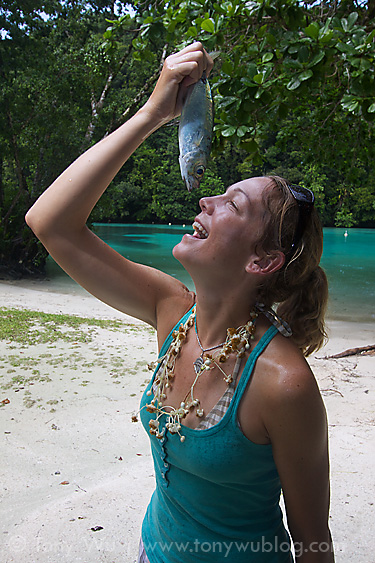
Terry had me worried at one point
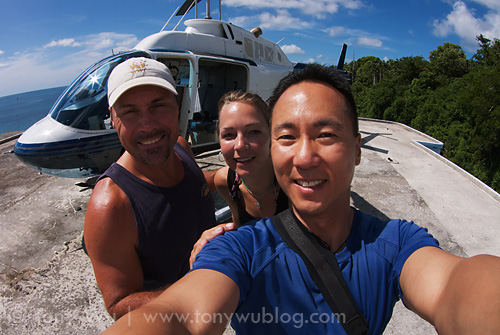
Ron, Terry and me just before going up with Palau Helicopters
to take a tour over the Rock Islands...Thanks Matt!